Hamhung
Hamhung is North Korea’s second largest city but has been closed to tourists for nearly 60
years. We were the first Western tourists allowed in the city since before the Korean War,
and it was an absolutely amazing experience to watch people and their reactions to us. The
drive north from Wonsan to Hamhung also included territory that no Western tourist had ever
seen before, so I have also included pictures of several random roadside scenes taken from
bus windows on that road in an attempt to capture what honest daily life is like on a random
road on a random day in a country that -- until this trip -- always tried to choreograph
every experience and every image that tourists could see and photograph.
---------------------------------------
Even on large roads, I was always amazed at the number of people walking and carrying
things. In a country where no public transportation exists and almost no one owns a car,
walking is often the only way to get from Point A to Point B. People often tried to flag
down our tour bus and hitchhike.

---------------------------------------
One of the (many) things that the North Korean minders don't like you to photograph is
anything that makes their country look poor. One person on our bus was specifically told
that no photos of ox carts would be allowed. But since I (purposely) sat on the opposite end
of the bus from this minder, I was never advised of this prohibition personally and did not
feel guilty about snapping this shot.

---------------------------------------
More evidence of poverty and shortages caught on film. Below, one of the countless smoke-belching wood gas trucks that we saw on our drive. With petrol in short supply, North
Koreans have become quite efficient in trying to find other sources of propulsion.

---------------------------------------
Roadsides were filled with bicycle riders and manual laborers who often had to move out of the way
when we would pass.

---------------------------------------
Random roadside propaganda sign, the kind which crop up every few minutes on North Korea
roads. The main slogan across the bottom reads, "Let the entire party, entire army, and
entire people advance upholding the revolutionary military-first leadership of the Great
Leader Comrade Kim Jong Il." The red flags next to the torch proclaim, "Military first
revolutionary line," "Defend to the death," and "A whole, rich, and harmonious country."

---------------------------------------
Due to the complete lack of public transport, flatbed trucks were always stuffed with
passengers, goods, or both.

---------------------------------------
We noticed right away that soldiers and civilians always seemed to be sharing these
impromptu rides, leading to open speculation about the lack of military transport vehicles
as well. You can see that the civilians in the bunch seem to be giving the soldiers their
own area to sit down and relax in.

---------------------------------------
Another typical North Korea roadside sight: square concrete apartment blocks in the middle
of nowhere.

---------------------------------------
The buildings don't get any more attractive as they get larger closer to the city.

---------------------------------------
And even in cities, the ox carts are still common sights.

---------------------------------------
One interesting development in North Korea in recent months has been the proliferation of
little roadside kiosks selling snacks, drinks, or other goods (see bottom left in this
picture). The first stirrings of life for free enterprise in the country, perhaps?

---------------------------------------
Another thing we were expressly forbidden to photograph was anything to do with soldiers or
the military. But this proved almost impossible to adhere to given the fact that soldiers
are literally everywhere. And thankfully the rule was enforced haphazardly at best. One of
our minders ripped into me after seeing me sneak a picture of soldiers while later another
minder suggested I try the following approach: don't purposely take pictures of soldiers,
but if soldiers just "happen" to be in my picture, it can't be helped...
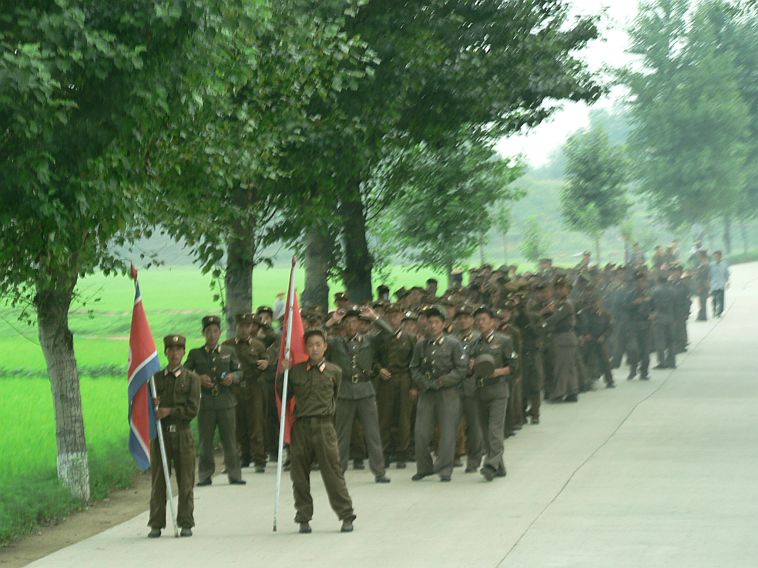

---------------------------------------
Just inside the Hamhung city limits, a giant statue of the Great Leader Kim Il Sung.
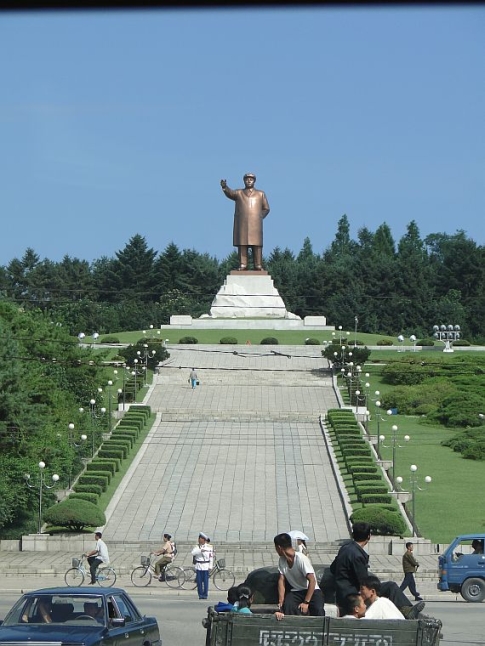

---------------------------------------
At the above Kim Il Sung statue looking back down the hill at the main road. I love this
picture because it shows many things all at once: the plethora of pedestrians and bike
riders, the overflowing cart, the three girls in the bottom right who followed us at a great
& safe distance as they stared transfixed by the sight of foreigners, the guy in the center
of the intersection waiting to direct (nonexistent) traffic. I couldn't help but wonder if
the Great Leader would be sad that the people of North Korea still need ox carts to move
goods in the year 2010.

---------------------------------------
We had lunch at the gorgeous Sin Hung San Hotel, said to be the finest hotel in Hamhung.
Like many hotel restaurants in North Korea, the place is decked out with some positively
breathtaking floor to ceiling nature paintings.
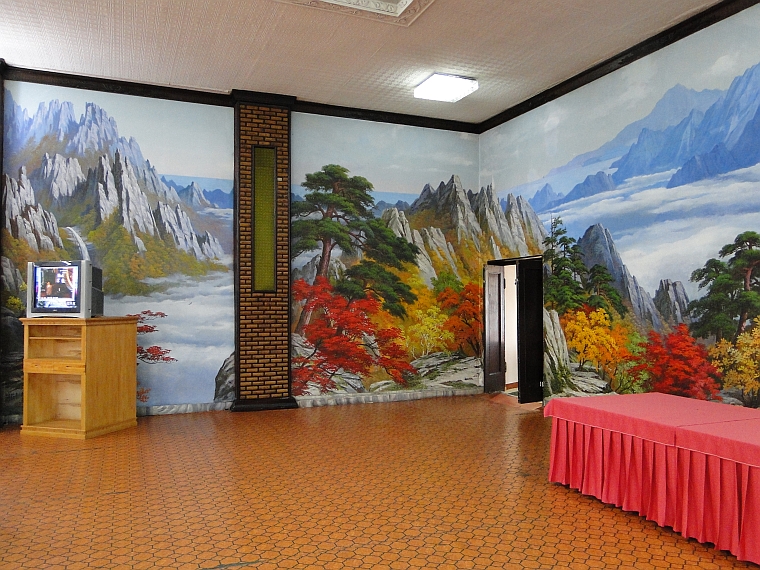

---------------------------------------
One of Hamhung's greatest sites and one that the guides couldn't wait for us to see - the
massive Hungnam Fertilizer factory! Huh? Most of us were amazed not so much by the factory
but by the fact that the North Koreans would expect Western tourists would travel thousands
of miles to come to their country -- and be the first tourists ever allowed into this city
-- so that we could tour a fertilizer factory. Yet there we were...

---------------------------------------
As far as fertilizer factories go, there was no denying this place was impressive. And
massive. The Great Leader and Dear Leader both have made multiple visits to offer their
famed "on the spot guidance" over the years, which probably explains our minders' enthusiasm
for the place. We were actually walking in the footsteps of these demigods! But
truthfully, inside not much was happening. A lot of employees standing around looking bored
(actually, they were monitoring a series of pressure gauges), as seen below.

---------------------------------------
Outside some of the compound's buildings.

---------------------------------------
Not only were we lucky to be the first group of Western tourists ever to visit Hamhung, but
our visit happened to coincide with a revolutionary opera troupe being in town, performing
"The Fate of a Member of the Self Defense Corps." Crowds were already waiting out front of
the Hamhung Grand Theater by the time our bus pulled up.

---------------------------------------
Closeup of the bas relief on the theater exterior.
This is actually an image from the
climax scene of the opera we were about to witness.

---------------------------------------
It was a bizarre experience watching people trying to figure out how to react to us. We saw
every possible facial expression from fear, happiness, indifference, curiosity, and mouth-
dropping amazement. When it came time to actually enter the theater, our group was treated
to resounding applause from the locals present. They must have assumed we were part of an
important foreign delegation.
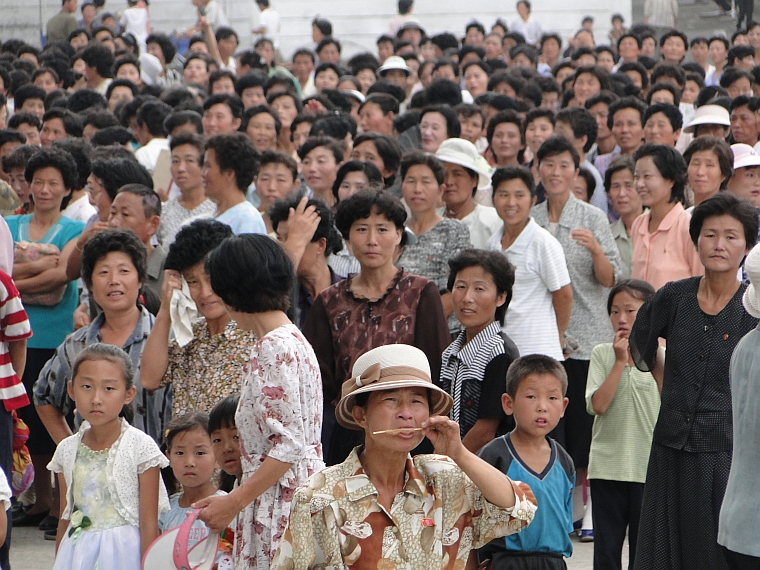

---------------------------------------
Inside the Hamhung Grand Theater, a feast for the eyes from the several story tall mural of
the Great & Dear Leaders, sparkling chandeliers, spiral marble staircases, and near lifelike
statuary.
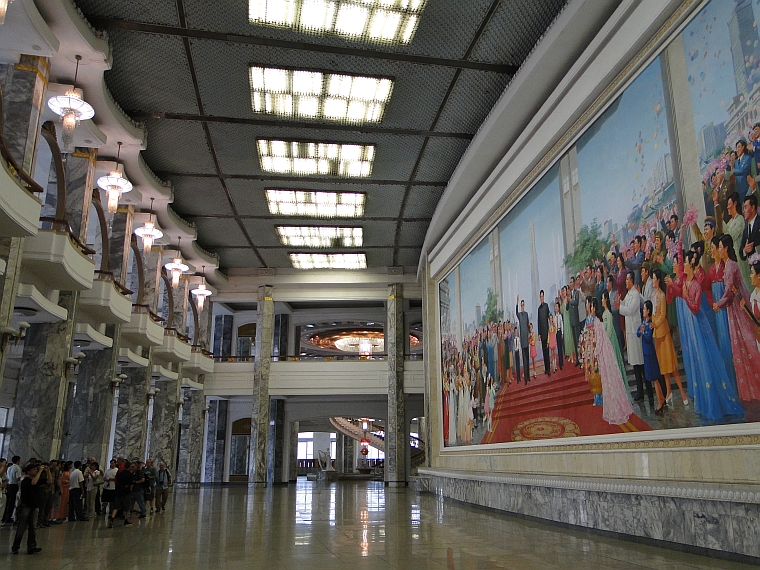

---------------------------------------
A couple closeups of the giant mural inside the theater. The Great Leader & Dear Leader
waving to the welcoming throngs, followed by a closeup of ladies in obvious rapture.
Adoration like that simply cannot be faked!
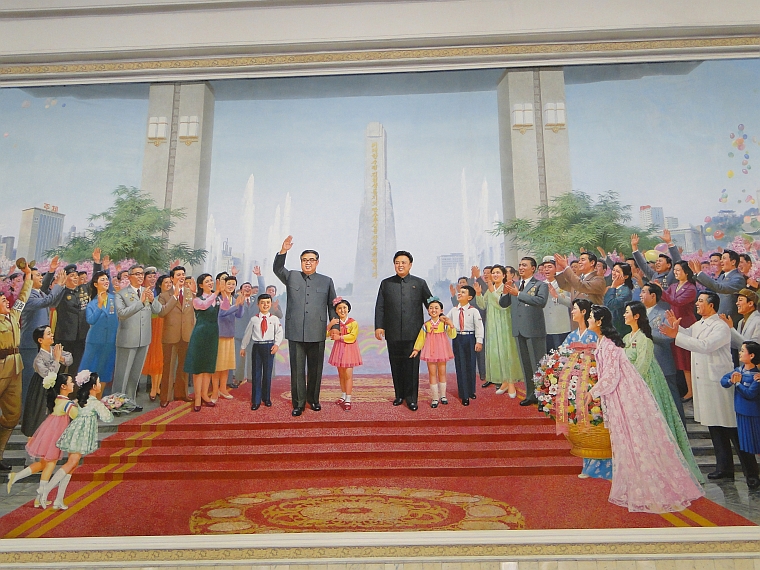

---------------------------------------
The opera itself was sensational. And although it was entirely in Korean (of course), it
was easy enough for us to follow the plot. Lots of singing and dancing about how happy and
prosperous Korea was before the Japanese rudely annexed the country and ruined
everything.

---------------------------------------
The fate of this particular Self Defense corpsman was execution at the hands of his evil
Japanese overlords. I can still hear the piercing scream of his daughter in anguish. Such
a tragedy is not wasted, however, as it rallies the villagers to finally fight back. The
photograph below conveys the quintessential revolutionary artistry in the final scene, and
there's no mistaking the symbolism of the peasant/oppressed class overthrowing the evil
occupiers with nothing more than simple farm tools and bottomless resolve!
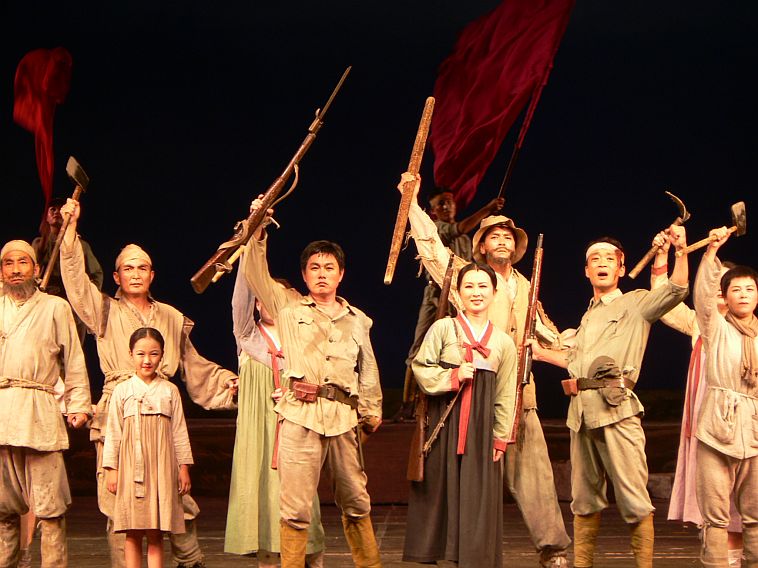
---------------------------------------
Street scene as we exited the theater. More overloaded pickup trucks. Lots of pedestrians
and bicyclists. But we saw a lot of smiles too. School kids waved at us from across the
street. Most people looked at us with shy smiles. It was an interesting contrast to
Pyongyang, where in most cases the local people make you feel invisible. Clearly the people
of Hamhung haven't yet been told by the authorities that they're not supposed to acknowledge
foreigners, much less smile and wave at them.

---------------------------------------
On our way out of the city, we drive by a Kim Il Sung statue with a clenched fist. I would
have loved to stop here if nothing for the variety, but of course this was out of the
question as there was already a big group of locals there. I like this pose much better
than the usual arm outstretched which always makes me secretly snicker with the idea that
he's trying (and failing) to hail a cab.

---------------------------------------
Checkpoint as we leave Hamhung. Of course checkpoints were also added to the lengthy and
ever-growing list of things we weren't supposed to photograph, but they are a daily reality
in North Korea. People cannot travel freely even within their own country, and checkpoints
like these serve to control the flow of people in and out. Here, the soldier is readying
his red flag to wave our bus to the side to have paperwork checked. Interestingly enough, I
noticed that at most checkpoints only vehicles were stopped. People on foot simply walked
by the guards. Those riding bikes would get off the bike, walk past the guards, and then
get back on and start peddling again. Only vehicles were inspected thoroughly.

---------------------------------------
We were actually forced to leave Hamhung; the welcome to the first group of tourists ever
to be let in to the city could only go so far. There were rumors that the city elders did
not want Americans stay overnight there for some reason. We were told we would probably
have to travel back down the coast for two hours to Wonsan in order to find a place that
would accept us. In the end, a compromise was reached, the Majon Guesthouse. Completely
isolated from everything and everyone, just like the North Korean government likes to
control tourists. But it was nice to stay on the beach for a change of pace. Here is the
impressive main building of the guesthouse.

---------------------------------------
The actual rooms, however, were much less appealing. There was little running water, and we
were instructed to immediately fill up the bathtub on the rare occasions that water did
work. That way we would have some water stored up for important things like washing. And
flushing the toilet (water had to be transferred from the bathtub to the toilet manually in
a plastic bowl whenever we wanted to use the toilet). At least the beach was nice, as the
picture below shows. And since there are so few people in this part of the country, it was
great for beachcombing with lots of pretty shells and other odd things from the depths.

---------------------------------------
I stuck with beachcombing in my free time because, as expected, the hotel bookstore didn't
have much variety.

---------------------------------------
A new day up in the country's northeast brings a new day of sightseeing. Here, a stop at
the home of Ri Song Gye, first king of the Li Dynasty. In contrast with South Korea, which
the North says is ruined by Westernization, North Korea is always quick to point out places
and areas where real authentic Korean culture is preserved.

---------------------------------------
And what journey to the North Korean countryside would be complete without a visit to a
cooperative farm? First we were taken to a tractor depot/museum, which was every bit as
scintillating to our group of Western tourists as our visit to the fertilizer factory had
been. Then it was off to the Tongbong Cooperative Farm, which we were told was typical of
North Korean farms but was so perfectly manicured and green that it reeked of staged photo
op. Nonetheless, it did project a very appealing face. Here, some of the beautiful farm
homes from the outside.

---------------------------------------
And from the inside. Immaculate, of course, or we wouldn't have been allowed to be there.
But just once I would like to see some pictures of someone -- anyone -- other than the
country's ruling dynasty.

---------------------------------------
As with everywhere else we visited in North Korea's remote northeast, somewhat shy kids
smiled and waved.
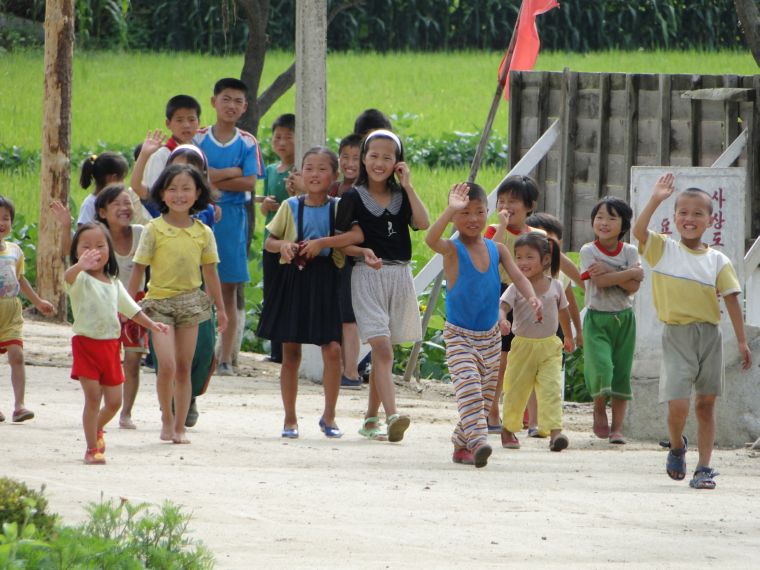

---------------------------------------
But even here out in the middle of nowhere on a cooperative farm, the endless parade of
tributes for the Leaders marches onwards. This giant cenotaph isn't even completed yet, but
it doesn't take a lot of imagination to guess whose portrait will soon adorn it.

---------------------------------------
Time to hit the road again. Below a few random road shots as a farewell glimpse to North
Korea's eastern provinces...




